Digital twin technology refers to a digital replica of a physical entity or system. This technology involves creating a virtual model that mirrors a physical object, process, system, or service. The primary purpose of digital twins is to simulate, analyze, and predict real-world conditions on their virtual counterparts without the risk of actual physical failure. This allows for better planning, maintenance, and troubleshooting, leading to improved operational efficiency and reduced costs.
Digital twins integrate various technologies including Internet of Things (IoT) sensors, artificial intelligence (AI), and software analytics to gather and process real-time data about the physical world. This technology is widely used across many sectors, including manufacturing, automotive, healthcare, and urban planning, where it helps in optimizing the performance and efficiency of systems and processes.
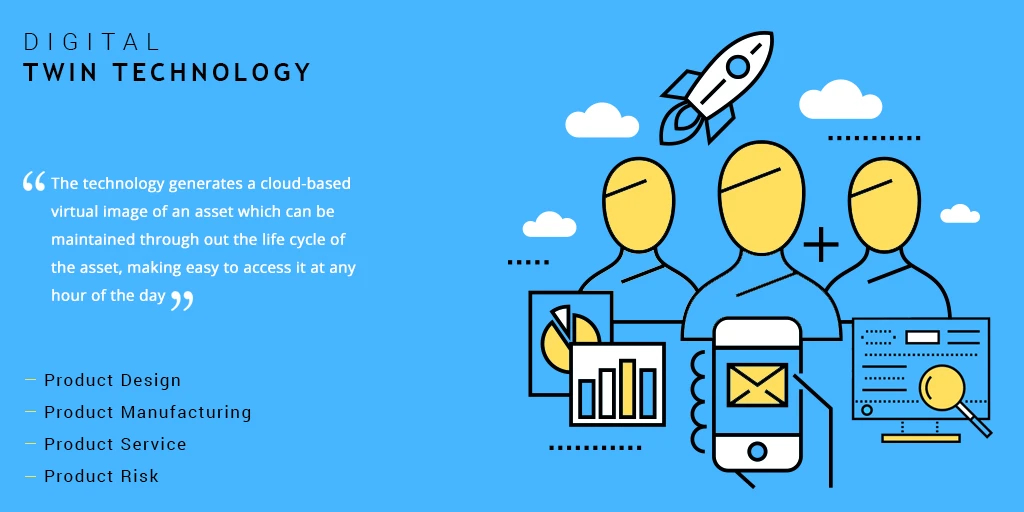


Digital twins in various sectors utilize a wide range of sensors to collect the necessary data for creating and maintaining their virtual replicas. These sensors play a crucial role in capturing real-time information that digital twins use to simulate and predict outcomes.
Types of sensors used to implement digital twin technology
Here are some common types of sensors used across different industries to implement digital twin technology:
- Temperature Sensors: Used extensively in manufacturing, energy, and agriculture sectors, these sensors help monitor machine health, environmental conditions, and process parameters, essential for predictive maintenance and energy management.
- Pressure Sensors: In industries like oil and gas, aerospace, and automotive, pressure sensors are vital for monitoring equipment and systems under pressure. They help ensure safety and efficiency by detecting leaks, predicting failures, and maintaining optimal operating conditions.
- Flow Meters: Common in water management, chemical industries, and manufacturing, flow meters measure the flow rate of liquids and gases, providing critical data for operational efficiency and process control in digital twins.
- Vibration Sensors: These are critical in sectors such as manufacturing and transportation, where they monitor the health of machinery and vehicles. Vibration sensors can detect imbalances, misalignments, or bearing failures before they lead to major breakdowns.
- Proximity Sensors: Used in automated production lines and robotics within the manufacturing sector, proximity sensors help digital twins simulate and optimize the assembly processes by tracking the presence and position of objects and components.
- Light Sensors: In smart city applications, light sensors contribute to managing and optimizing lighting systems, enhancing energy efficiency and public safety.
- Humidity Sensors: Vital in agriculture and food industries, these sensors help maintain optimal conditions for crop growth or food storage, directly feeding data into digital twins that manage agricultural or supply chain operations.
- Acoustic Sensors: Used in infrastructure and city management, these sensors can detect noises or vibrations indicative of faults or failures, such as in water pipes or bridges, aiding in preventive maintenance and safety measures.
- Chemical Sensors: In environmental monitoring and healthcare, chemical sensors detect and measure chemical compositions in the air or other mediums, providing data used by digital twins to monitor pollution levels or manage chemical processes.
Each type of sensor feeds specific and valuable data into the digital twin system, enabling a dynamic and accurate virtual model that reflects the current state of physical assets, processes, or environments, facilitating better decision-making and predictive maintenance across various sectors. Also, Read: Trends in Welding Technology
Let us learn in detail on how dgital twin is implemented by taking human heart as example
The implementation of a digital twin for the human heart is a sophisticated process that involves multiple steps, integrating various technologies from medical imaging to computational modeling and real-time data processing.
General Outline for Digital Twin Technology
Here’s a general outline of how a digital twin of the human heart can be developed and utilized from end to end:
1. Data Collection
The first step involves collecting detailed anatomical data of a patient’s heart. This is typically done using advanced medical imaging techniques such as MRI (Magnetic Resonance Imaging), CT scans (Computed Tomography), and ultrasound. These imaging technologies provide high-resolution images that capture the unique structures and dynamics of the patient’s heart.
2. Model Creation
Using the collected imaging data, a detailed 3D model of the heart is constructed. This model includes not just the anatomical structure but also incorporates the physiological and biomechanical properties of the heart tissues. Advanced software tools are used to convert the 2D image slices into a comprehensive 3D model.
3. Simulation and Validation
The 3D heart model is then used to simulate heart functions and behaviors under various conditions. Computational fluid dynamics (CFD) and finite element analysis (FEA) are commonly used to simulate blood flow dynamics and tissue stresses, respectively. These simulations must be validated with actual clinical data to ensure accuracy, involving iterative adjustments based on feedback from medical experts.
4. Integration with Real-Time Data
To transform the static 3D model into a dynamic digital twin, it is integrated with real-time data from the patient. This data can come from wearable devices, implanted sensors, or routine medical tests that provide information on heart rate, blood pressure, and other critical parameters. This integration allows the digital twin to reflect the current state of the patient’s heart.
5. Predictive Analytics and Machine Learning
With the digital twin established, machine learning algorithms can be applied to predict future heart conditions and potential risks based on the ongoing analysis of the accumulated data. These predictions can help in proactive medical planning, such as anticipating cardiac events or evaluating the effectiveness of a treatment plan.
6. Clinical Application
The digital twin serves as a powerful tool for clinicians. It can be used for pre-surgical planning, allowing surgeons to explore different strategies and anticipate outcomes before actual procedures. It also aids in personalized medicine, as treatments and interventions can be tailored based on the simulated responses of the digital twin.
7. Monitoring and Updates
Finally, the digital twin is continuously updated with new data from the patient, ensuring it remains an accurate replica over time. This ongoing process allows for the monitoring of disease progression or recovery and adjustments in treatment plans as needed. Also, Read: Trends in Electrical Cables
This end-to-end process shows how digital twins in healthcare, particularly for complex organs like the heart, involve a deep integration of technology and clinical practice, offering a futuristic approach to personalized medicine and advanced patient care.
Benefits of Digital twin technology across various industries
Digital twin technology offers several significant benefits across various industries:
- Predictive Maintenance: By simulating physical assets in a virtual environment, digital twins can predict failures before they occur. This helps in scheduling maintenance activities effectively, reducing downtime and operational costs.
- Optimization of Operations: Digital twins allow for the testing of different scenarios and operational strategies in a risk-free virtual environment. This helps in finding the most efficient ways to operate machines, processes, and systems, enhancing productivity and reducing waste.
- Enhanced Product Design and Development: Engineers can use digital twins to test and refine designs virtually, reducing the need for physical prototypes. This speeds up the development process and leads to better-designed products with fewer real-world testing requirements.
- Real-time Monitoring and Control: Integrating IoT sensors with digital twins provides continuous feedback from physical assets. This real-time data helps in monitoring the condition and performance of equipment, enabling immediate corrective actions if necessary.
- Training and Simulation: Digital twins provide a detailed and accurate environment for training purposes without the risks associated with real-world training. This is particularly beneficial in industries like aerospace and healthcare, where training on actual systems can be either risky or expensive.
- Improved Customer Service: For businesses, digital twins can simulate how products are used in the real world, offering insights into performance and potential improvements. This can lead to better customer service by more quickly addressing product issues and developing enhancements.
- Sustainability: By optimizing processes and reducing waste, digital twins contribute to more sustainable operations. They help in better energy management and reduced carbon footprints by streamlining operations and minimizing resource usage.
Digital twin technology is utilized across a wide range of industries, each harnessing its capabilities to improve efficiency, reduce costs, and innovate in unique ways. Also, Read: Trends in Solar Energy, Systems, and Products
Here are some key industries where digital twins are making a significant impact:
Digital Twin Technology for the Manufacturing Industry
In manufacturing, digital twins are used to create and simulate factory layouts to optimize the assembly lines before they are physically built. They also help in monitoring machinery and predicting when maintenance is needed, thus minimizing downtime and extending equipment life.



Digital Twin Technology for Product Design and Development:
- Digital twins allow for the virtual creation and testing of products before any physical prototypes are manufactured. Engineers can simulate how a new product will behave under various conditions, allowing for iterative design improvements based on real-world data. This reduces both the time and cost associated with traditional prototyping and testing, leading to faster product development cycles.
Production Process Simulation:
- Manufacturers use digital twins to create detailed simulations of their production lines. This allows them to identify potential bottlenecks or inefficiencies before they impact actual production. By adjusting the production process in the digital twin, companies can ensure that the physical processes will be more efficient, thereby reducing waste and increasing productivity.
Predictive Maintenance:
- Digital twins monitor the condition of machinery and predict when maintenance should be performed to prevent unexpected breakdowns. This is achieved by analyzing data from sensors embedded in manufacturing equipment, which track performance and detect anomalies indicative of potential failures. Predictive maintenance helps extend the lifespan of equipment and minimize downtime, significantly reducing maintenance costs.
Quality Control:
- In manufacturing, maintaining product quality is paramount. Digital twins help by continuously monitoring the manufacturing processes and instantly analyzing if the output meets the quality standards. Adjustments can be made in real-time to ensure products are consistently produced within specification, reducing the incidence of defects and rework.
Supply Chain Management:
- Digital twins offer a comprehensive view of a manufacturer’s supply chain, providing insights into inventory levels, logistical operations, and potential disruptions. By simulating different supply chain scenarios, companies can optimize their inventory levels, enhance delivery times, and reduce costs while maintaining the ability to adapt to changes and disruptions quickly.
Customization and Personalization:
- For industries that benefit from customized products, such as automotive and aerospace, digital twins facilitate the modification of designs to meet specific customer demands without the need to alter the entire production line. This flexibility allows for efficient customization while maintaining high production efficiency.
Worker Training and Safety:
- Digital twin technology simulates manufacturing environments for training purposes without exposing workers to risks. This technology provides a virtual hands-on experience that is vital for training on complex equipment, helping to improve safety and operational efficiency by better preparing workers for their roles.
Environmental Impact Analysis:
- Companies use digital twins to model and analyze the environmental impact of their manufacturing processes. By simulating changes to production methods or resource utilization, companies can find ways to reduce energy consumption, minimize waste, and overall lessen their environmental footprint.
Integration with IoT and Robotics:
- Digital twins integrate with IoT devices and robotics to enhance automation in smart factories. This integration allows for the seamless coordination of advanced manufacturing robots and IoT sensors, optimizing production lines for greater productivity and reduced human error. Also, Read: Safety in Cement Plants and Technology
Several prominent companies have successfully implemented digital twin technology in their manufacturing processes and have publicly shared their success stories.
Here are a few notable examples:
- Industry: Aerospace and Energy
- Application: GE has employed digital twins extensively across its range of products, including jet engines and wind turbines. They use digital twins to monitor equipment performance and predict maintenance needs, significantly reducing unplanned downtime. In one instance, GE reported that using digital twins for its wind farm operations increased energy production by up to 20% by optimizing each turbine’s performance in real-time.
- Industry: Industrial Manufacturing
- Application: Siemens uses digital twins to optimize its manufacturing processes, particularly in its electronic works facility in Amberg, Germany. The digital twin of their production line allows them to simulate, test, and optimize the processes involved in the production of automation systems. This approach has resulted in higher productivity and flexibility, and Siemens has been able to achieve about 75% automation in its factories, with remarkably high quality and efficiency rates.
- BMW:
- Industry: Automotive
- Application: BMW employs digital twins to streamline its automotive production processes. The digital twins help BMW in customizing cars according to individual customer specifications directly on the assembly line. This digital twin technology allows for adjustments to be made on the fly during the manufacturing process, reducing waste and improving customer satisfaction with more personalized vehicles.
- Industry: Various manufacturing sectors
- Application: TwinThread offers predictive operations platforms that leverage digital twin technology. They cater to multiple industries, enabling companies to predict failures before they occur and suggesting optimal operating parameters. Companies using TwinThread have reported significant improvements in operational efficiency and energy management.
- Industry: Oil and Gas
- Application: Shell uses digital twins for its offshore platforms, refineries, and other assets. The digital twins enable Shell to simulate different operational scenarios to improve safety and efficiency. This has been particularly effective in reducing downtime and optimizing maintenance schedules, which is crucial in an industry where equipment failures can lead to significant production losses and safety risks.
Digital Twin Technology for the Automotive Industry
Automotive companies use digital twins to simulate vehicles under various conditions to improve design and performance. They also use this digital twin technology for the predictive maintenance of vehicles and to enhance the manufacturing processes.
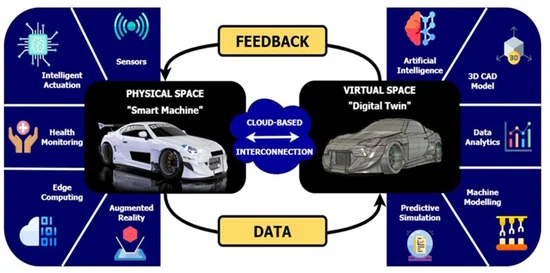


Digital Twin Technology for Vehicle Design and Development
Automakers use digital twins to simulate vehicle performance under various conditions, including different climates, road surfaces, and driving styles. This allows engineers to optimize vehicle designs for performance, safety, and durability before physical prototypes are ever built.
Production Line Optimization
Digital twins of automotive production lines help manufacturers visualize and optimize the assembly process. They can simulate different production scenarios to find the most efficient workflows, identify potential bottlenecks, and reduce the time it takes to bring a vehicle from concept to market.
Predictive Maintenance and Remote Monitoring
By equipping vehicles with sensors that feed data back to their digital twins, manufacturers can monitor vehicle health in real-time. This data can be used to predict when parts might fail and schedule maintenance proactively, which enhances vehicle reliability and customer satisfaction.
Autonomous Vehicle Testing
Digital twins are crucial in the development and testing of autonomous vehicle technologies. They allow for the simulation of millions of driving scenarios within a virtual environment, providing a safe and efficient method for testing and validating autonomous driving systems. Also, Read: Plastic Trends in USA (Specific Use in Automotive Sector)
Supply Chain Management
Automakers use digital twins to model and manage their supply chains more effectively. This includes everything from tracking parts inventory to optimizing logistics for just-in-time manufacturing processes, reducing costs and improving efficiency.
Customization and Configuration
Digital twins allow customers to customize their vehicle options virtually. Customers can see the potential outcomes of their choices in a virtual model, including color, interior materials, and other accessories, enhancing the buying experience and ensuring satisfaction.
Battery Management and Development
In the electric vehicle (EV) sector, digital twins help optimize the performance and lifecycle of batteries. They simulate various operating conditions and usage patterns to better design battery systems and manage their health over time. Also, Read: Wastewater Coagulation: Is an efficient water treatment method?
Here are four automotive companies that have successfully implemented digital twin technology, showcasing its versatility and effectiveness within the industry:
- Bosch: Bosch utilizes digital twins in its operations to enhance automotive logistics. By creating digital replicas of their machinery and logistics processes, Bosch can optimize workflows, reduce costs, and manage supply chain complexity more effectively (Automotive Logistics).
- HAVELSAN: This company has demonstrated the effectiveness of digital twins in improving manufacturing efficiency. In a detailed case study, HAVELSAN achieved a 6.01% increase in production line efficiency and an 87.56% reduction in downtime through the application of digital twin technology (MDPI).
- General Motors (GM): GM uses digital twins to simulate and optimize their manufacturing processes, from vehicle design to assembly. This digital twin technology allows GM to predict potential issues and test solutions in a virtual environment, thereby reducing physical prototyping costs and accelerating product development (Default).
- Tesla: Tesla incorporates digital twin technology to streamline vehicle production and predictive maintenance. By continuously updating the digital replicas of their vehicles with real-time data, Tesla can anticipate maintenance needs and refine vehicle designs based on actual performance metrics (Default).
These companies illustrate how digital twin technology is transforming the automotive industry by enabling more efficient manufacturing processes, enhanced product quality, and improved operational decision-making. For more detailed information on how these companies are using digital twins, you can refer to the in-depth articles and reports from industry sources like MDPI and Automotive Logistics.
Digital Twin Technology for the Healthcare Industry
Digital twin technology is revolutionizing the healthcare industry by providing more personalized medical treatments and improving hospital operations.
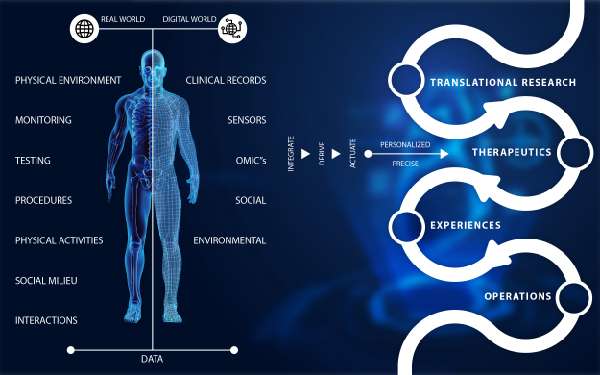


Here are some specific examples of how digital twins are used in healthcare:
Digital Twin Technology for Patient-Specific Models
Digital twins of individual patients are created to simulate and analyze the health conditions based on real-time data collected through sensors and medical devices. These models help in understanding how different treatments might affect a patient, allowing for highly personalized therapy plans. For example, a digital twin of a patient’s heart can be used to predict how it will respond to different types of medication or surgical interventions.
Surgical Preparation and Simulation
Surgeons use digital twins to prepare for complex surgeries. By creating a virtual replica of a patient’s organ or body part, surgeons can practice the surgery in a virtual environment, reducing the risk and increasing the precision during actual surgical procedures. This is particularly useful in orthopedic, cardiovascular, and neurosurgery.
Prosthetics and Implants Design
Digital twins are used in the design and testing of prosthetics and implants tailored to individual patients. By simulating how a specific design will interact with the patient’s body, healthcare professionals can ensure better compatibility and performance of the medical devices.
Hospital Management and Operations
Digital twins of hospital environments help in optimizing the management of healthcare facilities. This includes everything from patient flow, bed management, and equipment utilization to emergency response systems. By simulating different operational scenarios, hospitals can improve efficiency and patient care.
Drug Development and Trials
In pharmaceuticals, digital twins simulate the human response to new drugs, allowing for safer and more efficient drug development processes. This digital twin technology can model how drugs interact with the body, helping to predict outcomes and side effects without the need for extensive clinical trials.
Chronic Disease Management
Digital twins are used to continuously monitor patients with chronic illnesses such as diabetes and heart disease. These models can predict exacerbations and recommend preventative measures, helping to manage the disease more effectively and improve the patient’s quality of life. Also, Read: Solid-State Batteries
Here are several real-life examples of how digital twin technology is being applied in the healthcare sector:
- Johns Hopkins University: Researchers at Johns Hopkins are using digital twins for personalized treatment plans in cardiology. Specifically, they’ve developed digital twins to simulate the electrical activity in the heart to treat patients with heart rhythm disorders effectively. This innovative approach helps in predicting arrhythmias and determining the most effective interventions for each patient.
- Siemens Healthineers: Siemens has developed digital twins for cardiac care, focusing on pharmacological therapy and simulations for cardiac catheterization. This application aids in personalized medicine by allowing for the customization of treatments based on a patient’s specific heart dynamics.
- Cleveland Clinic: Cleveland Clinic utilizes digital twins to understand how a patient’s environment affects their health. By creating digital replicas of neighborhoods, they can simulate and assess health outcomes influenced by socio-economic factors, aiming to improve health equity and plan public health interventions more effectively.
- Philips: Known for its innovations in healthcare technology, Philips has developed ‘digital patients’ to enhance care delivery. These digital twins of human bodies allow healthcare professionals to provide more integrated and personalized care throughout a patient’s lifetime, optimizing treatments and interventions based on the comprehensive health data.
These examples illustrate the diverse applications of digital twin technology in healthcare, from enhancing cardiac care to improving public health strategies. For further details on these implementations, you can visit the websites of HealthTech Magazine, Stefanini, and Hologram.
Digital Twin Technology for the Energy Sector
The energy sector employs digital twins to enhance the performance and maintenance of equipment such as wind turbines and oil rigs. It helps in predicting equipment failures and optimizing energy production, significantly reducing costs and environmental impact.
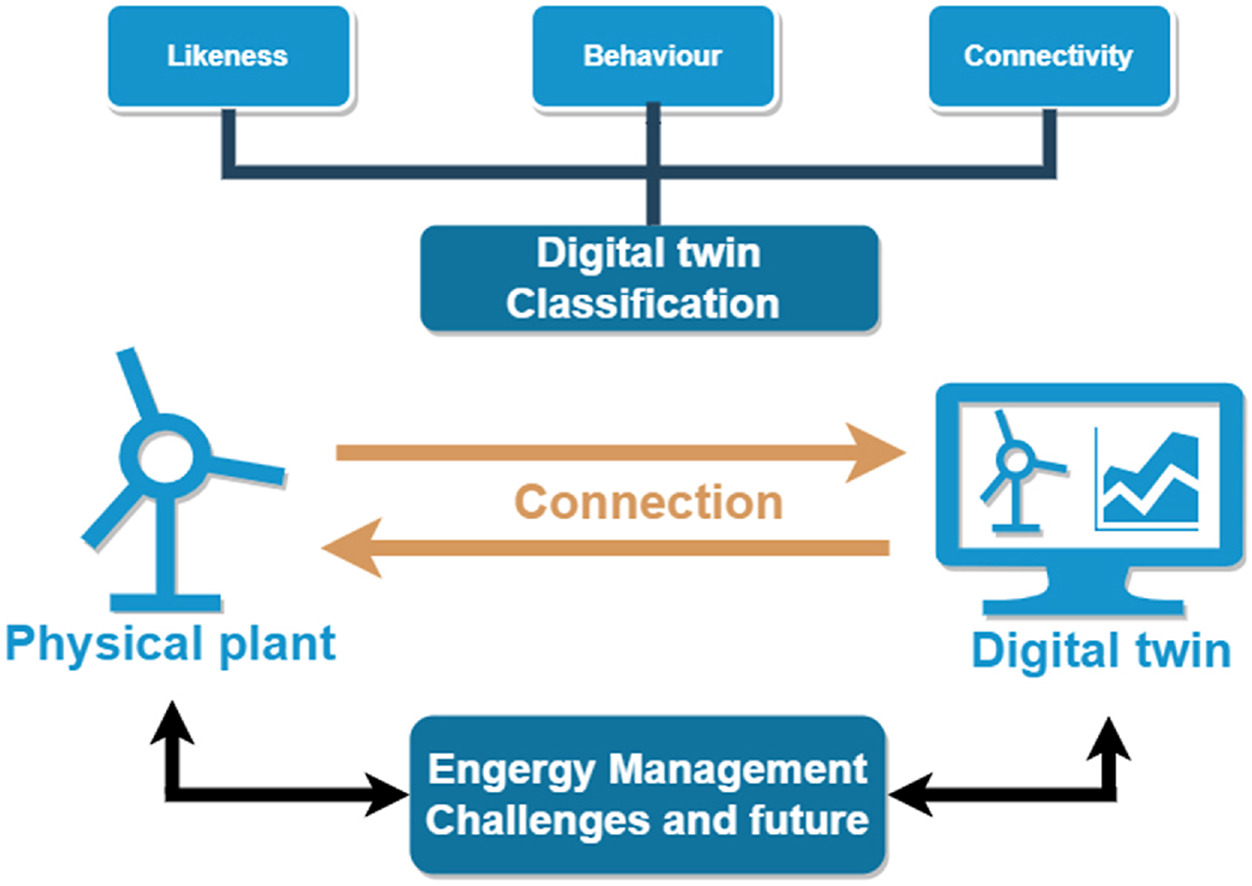


Digital Twin Technology for Grid Management
Digital twins model the entire electrical grid to provide real-time analytics and simulations. This digital twin technology can predict the impacts of changes or disruptions (like power outages) and suggest optimal responses to maintain stability and efficiency. It helps operators visualize and manage the flow of electricity, anticipate problem areas, and implement preventative measures to minimize disruptions.
Asset Management
Using digital twins for asset management involves creating digital replicas of physical assets such as turbines, transformers, or entire substations. These twins collect data from sensors on the physical assets to monitor their condition continuously. The system can alert operators about signs of wear or impending failures, allowing for timely maintenance and thus reducing unplanned downtime and extending the asset’s lifespan. Also, Read: Supercapacitors
Renewable Energy Integration
Digital twins assist in the integration of renewable energy by accurately modeling and simulating the behavior of wind turbines and solar panels under varying environmental conditions. This helps in predicting power generation fluctuations due to changing weather, thereby enabling more reliable integration into the power grid.
Energy Storage Optimization
In energy storage, digital twins simulate battery behavior to optimize usage and improve efficiency. They analyze patterns of energy demand and supply, helping to determine the best times for charging and discharging, thus enhancing the operational life and efficiency of storage systems.
Performance Optimization
For thermal power plants, digital twins are used to simulate operations such as the combustion process in boilers or the steam flow in turbines. This allows for tweaking processes in real-time to improve fuel efficiency, reduce emissions, and enhance the overall performance of the plant. Also, Read: Sodium-ion batteries
Safety Enhancements
In nuclear facilities, digital twins can simulate various operational scenarios, including emergency situations. This provides critical data that can be used to improve safety protocols and reactor designs, reducing the risk of accidents and enhancing the safety of nuclear operations.
Demand Response Management
Digital twins forecast energy consumption patterns and adjust the supply dynamically. This helps utility companies manage peak load times more effectively, reducing the strain on the grid and ensuring a steady energy supply during demand spikes.
Oil and Gas Exploration
Digital twins simulate drilling operations and reservoir behavior to maximize extraction efficiency and minimize environmental impact. They provide detailed insights into the reservoir properties and help in planning the extraction process, leading to more informed decision-making and optimal resource management.
Supply Chain Optimization
Digital twins map the entire supply chain of energy production, from raw material extraction to delivery. They can predict disruptions and suggest alternatives, optimizing the flow of materials and energy, reducing costs, and improving supply chain resilience.
Facility Management
Digital twins of facilities allow operators to conduct virtual inspections and monitor facility conditions without physical visits. This is especially useful for large or hazardous environments where frequent on-site inspections are impractical. It ensures regular monitoring and maintenance planning, leading to better facility management.
Companies working on digital twin in energy sector
Here’s a more detailed look at some companies working on digital twin in energy sector:
- Predictive Maintenance for Wind Farms: Clearway Energy Inc. uses digital twins to simulate various wind conditions to assess and predict the performance of wind turbines. This digital twin technology enables them to anticipate mechanical failures and optimize turbine operations, ensuring consistent energy production even during high wind conditions, thereby maintaining reliability and reducing unexpected downtimes.
- Solar Power Plant Management: At Topaz Solar Farm, digital twins monitor and manage the entire solar array, tracking performance and predicting maintenance needs. By employing digital twins, the farm has enhanced the efficiency of solar panels and effectively reduced maintenance costs, ensuring optimal energy output and longer lifespan of equipment.
- Heat Exchanger Operational Integrity: Siemens employs digital twins to manage the operational integrity of heat exchangers within energy facilities. The twins simulate thermal stresses and potential cracking scenarios, allowing for preventative measures to enhance safety and operational efficiency, thus minimizing risks and maintenance costs.
- Remote Operations of Wellhead Sites: Oilfield services utilize digital twins for remote monitoring and maintenance of wellhead operations. This reduces the need for physical presence at the site, cutting down on travel and manpower costs. It allows for early detection of issues and facilitates timely interventions, thereby improving safety and efficiency.
- VR Monitoring of Wind Turbines: Using 3D virtual and immersive digital twin technology, an energy infrastructure company creates digital twins of wind farms. These twins integrate various data types, enabling efficient decision-making and thorough performance analysis. This helps in optimizing turbine placement and operational strategies for maximum energy generation.
- Training with Robotics in Fuel Production: Digital twins simulate the environment and operation of robotic arms in fuel container processing. This allows for thorough training and testing before actual deployment, ensuring that the systems are fully operational and efficient from the start, thus minimizing potential operational delays and errors.
- Operational Efficiency in Large Infrastructure Sites: JTC Corporation leverages digital twins to integrate and analyze data from various sensors across large infrastructure sites. This helps in predicting energy demand and supply, optimizing resource allocation, and significantly reducing operational costs, particularly in cooling systems.
- Hydropower Plant Modernization: Digital twins aid in the modernization of aging hydropower plants by predicting the need for part replacements and updates. This proactive approach enhances the reliability of the plants and prevents failures, ensuring continuous and efficient energy production.
- Solar Construction Monitoring: Engineering firms use digital twins to plan and monitor the construction of large-scale solar PV projects. The digital twin technology allows for real-time adjustments during construction based on simulated predictions and drone data, optimizing layout and installation for peak performance.
- Payload Distribution Tracking in Mining: Digital twins provide immersive training environments for shovel operators in mining, delivering real-time data that helps improve operational efficiency and reduce training times. This digital twin technology ensures that new operators are skilled and fully prepared for their roles, enhancing productivity and safety.
Digital Twin Technology for the Aerospace Sector
Digital twins are extensively used in aerospace for the design and testing of aircraft components, reducing the need for physical prototypes. They also monitor aircraft health in the real-time, improving maintenance schedules and flight safety.



Digital Twin Technology for Aircraft Design Optimization
Digital twins allow engineers to test and optimize aircraft designs in a virtual environment before physical models are built. This involves simulating airflow, stress, and other operational conditions to enhance aerodynamics, fuel efficiency, and safety features. It accelerates the design process and reduces the need for costly physical prototypes.
Manufacturing Process Simulation
In manufacturing, digital twins are used to create virtual replicas of the production line. This helps in identifying bottlenecks, optimizing assembly sequences, and ensuring precision in the manufacturing process. This digital twin technology enables manufacturers to streamline operations, reduce waste, and ensure high-quality production.
Predictive Maintenance
Utilizing real-time data from aircraft sensors, digital twins can predict when components might fail and schedule proactive maintenance. This approach minimizes downtime and extends the lifespan of aircraft parts, leading to significant cost savings and increased aircraft availability.
Flight Simulation for Pilot Training
Digital twins replicate the flight conditions and behavior of specific aircraft models in simulation systems used for pilot training. This allows pilots to experience realistic flight scenarios, including emergency situations, without the risks associated with actual flight, enhancing both training quality and safety.
Fuel Efficiency Optimization
By analyzing flight data, digital twins can recommend optimizations in flight paths and operational parameters to reduce fuel consumption. This not only helps in cutting operational costs but also supports the aviation industry’s goals of reducing environmental impact.
Supply Chain Management
Aerospace companies use digital twins to monitor and manage their supply chain in real-time. This includes tracking parts inventory, predicting the need for component replacements, and optimizing logistics, which helps in maintaining a smooth production flow and reducing lead times.
Structural Health Monitoring
Digital twins continuously monitor the structural integrity of aircraft. They use sensor data to detect signs of wear or damage and can simulate the effects of detected flaws over time, helping to prevent structural failures and ensure the safety of the aircraft.
Customization of Specialized Aircraft
For military or specialized commercial use, digital twins simulate various configurations of aircraft to tailor them to specific missions or operational needs. This helps in determining the optimal setup for special equipment and technologies.
Lifecycle Management
Digital twins provide a holistic view of an aircraft’s lifecycle from design to decommissioning. They offer insights into the long-term performance and maintenance needs, helping aerospace companies make informed decisions about upgrades, refurbishments, and when to retire an aircraft.
Here are some real-life implementations that showcase the depth of digital twin applications in aerospace:
- NASA: NASA uses digital twins to simulate spacecraft operations and missions. This digital twin technology enables them to predict challenges and optimize mission parameters, significantly improving the success rate and cost-efficiency of space missions.
- Boeing: Boeing employs digital twins in the development of the 777X jet. The digital twin technology allows for the simulation of various design configurations and testing performance under different conditions, greatly accelerating development timelines and improving first-time quality of parts.
- Lufthansa Technik: Through its AVIATAR platform, Lufthansa Technik leverages digital twin technology for predictive maintenance. This platform integrates real-time data from aircraft systems to optimize maintenance processes, significantly reducing unplanned downtime.
- General Electric: GE uses digital twins in the development and manufacturing of the LEAP aircraft engine. This approach has streamlined testing and optimization processes, reducing the need for physical testing and resulting in considerable cost savings.
- Embraer: Embraer utilizes digital twins in the design and safety testing of their E-Jets E2 series. The technology helps simulate various flight conditions to identify and address potential safety concerns before the aircraft enter commercial service.
- Rolls-Royce: Rolls-Royce applies digital twin technology to optimize the performance of its Trent XWB engines, which power the Airbus A350 XWB. The digital twins help fine-tune engine performance, enhancing aerodynamics, fuel efficiency, and overall operational sustainability.
Digital Twin Technology for the Urban Planning and Smart Cities
Digital twins are instrumental in urban planning, where they simulate entire cities to predict traffic flows, optimize energy usage, and enhance emergency response systems. They help in designing more efficient and sustainable urban environments.
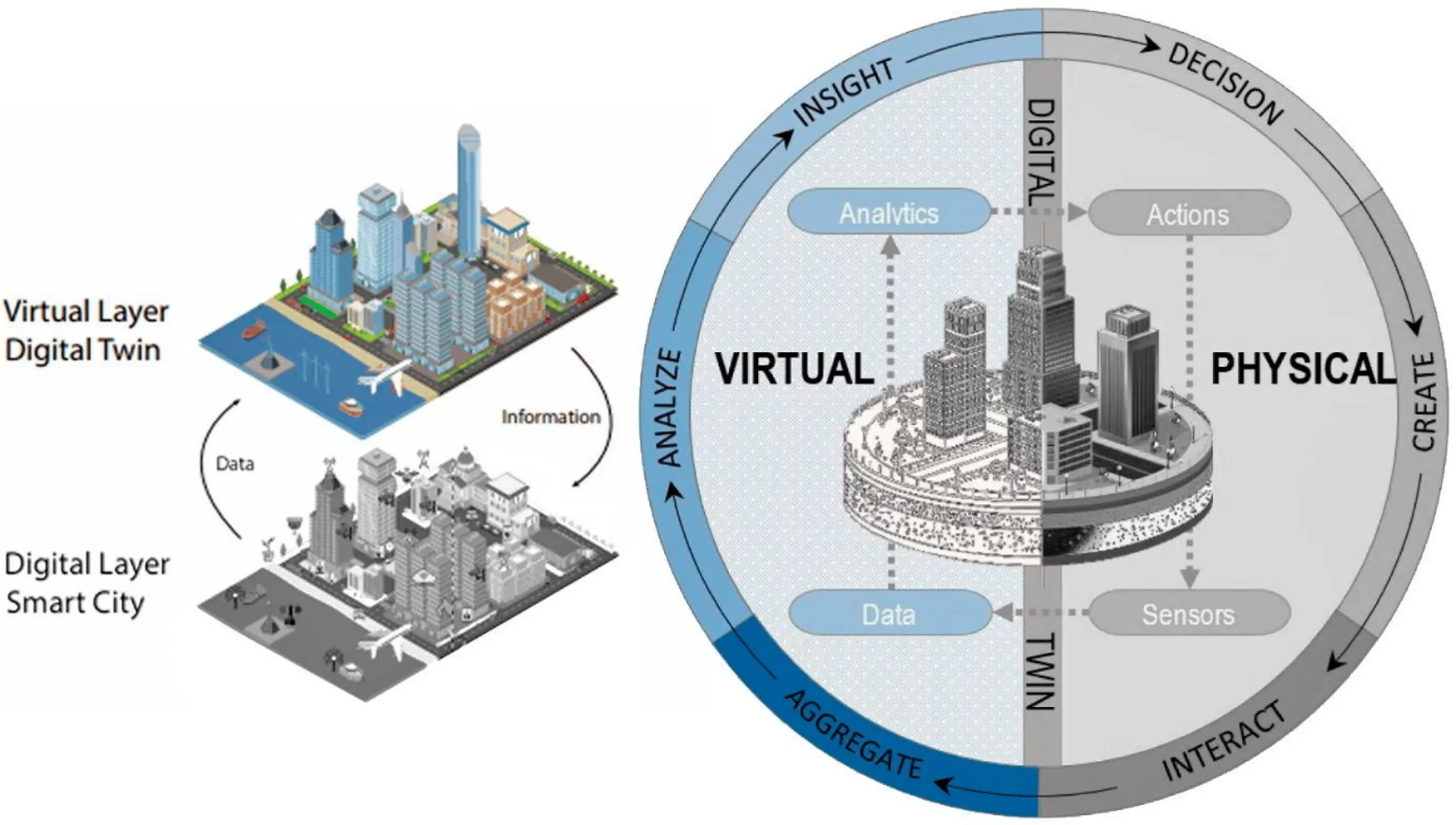


Here are nine detailed use cases that illustrate the potential of digital twins in this field:
Digital Twin Technology for City-Wide Infrastructure Management
Digital twins enable city planners to manage and monitor urban infrastructure such as roads, bridges, and public transport systems in real-time. This helps in predicting maintenance needs, managing traffic flow, and planning infrastructure upgrades with minimal disruption to city life.
Energy Consumption Analysis
Digital twins model the energy consumption of entire neighborhoods or buildings to identify inefficiencies and potential for energy savings. This allows urban planners to implement more effective energy policies and promote sustainable practices within the community.
Water Management Systems
Cities use digital twins to monitor and manage their water supply networks. By simulating water flow and demand, digital twins help in detecting leaks, planning water distribution, and ensuring efficient water use, which is crucial for conserving this vital resource.
Waste Management Optimization
By modeling waste collection and processing systems, digital twins help cities optimize routes for waste collection trucks, predict bin capacities, and manage recycling processes. This leads to more efficient waste management and a reduction in operational costs.
Public Safety and Emergency Response
Digital twins simulate various emergency scenarios to help city planners prepare response strategies. This includes everything from natural disasters to large public events, enhancing public safety through better preparedness and quicker response times.
Environmental Monitoring
Cities employ digital twins to monitor environmental parameters such as air quality, noise levels, and water quality. This data helps in making informed decisions regarding pollution control and environmental conservation efforts.
Urban Development and Land Use Planning
Digital twins provide a platform for simulating different development scenarios, allowing planners to visualize the impact of new buildings, parks, or roads before they are built. This helps in making better decisions about land use and urban layout to optimize space and improve livability.
Traffic and Transportation Systems
Digital twins simulate traffic patterns and public transit systems to improve the efficiency of transportation networks. This includes optimizing traffic light sequences, planning bus routes, and designing bike lanes to reduce congestion and enhance mobility.
Community Engagement and Public Participation
Digital twins can be used as interactive tools for community engagement. They allow residents to visualize proposed changes and provide feedback, fostering a more collaborative approach to urban development.
Real-life implementations of digital twin technology in urban planning and smart cities showcase a range of innovative applications that enhance city management and planning processes.
Here are some notable examples:
- Herrenberg, Germany: Herrenberg has developed a comprehensive urban digital twin which includes a 3D model of the city, simulations for urban mobility and wind flow, and participatory processes using virtual reality. This digital twin has been used in public participatory events to engage citizens in the urban planning process, demonstrating the potential for digital twins to enhance community involvement and decision-making in urban design (MDPI).
- Singapore: Known for its smart city initiatives, Singapore uses digital twins for scenario planning and to test urban development proposals. The digital twin technology allows planners to simulate the outcomes of planning decisions in great detail, helping to optimize land use, infrastructure, and public services (GovTech).
- Boulder, Colorado: Boulder utilizes Esri’s ArcGIS Urban to create digital twins for local scenario planning. This tool has drastically reduced the time needed for urban planning processes, from visualizing development impacts to optimizing city layouts (American Planning Association).
- Middle East: Digital twins are being leveraged to envision and plan the expansion of cities in the Middle East, allowing for precise, efficient, and cost-effective urban development. The digital twin technology is used to push the boundaries of design and planning, ensuring that new projects are both innovative and practical (PwC).
These examples illustrate the diverse and impactful ways in which digital twins are being applied to manage and plan urban environments more effectively, leading to smarter, more sustainable cities. For more detailed insights, you can explore further through the respective sources: GovTech, Planning, PwC, and MDPI.
Digital Twin Technology for the Retail Industry
In the retail sector, digital twins help manage supply chains and store layouts, analyze customer behavior, and optimize logistics. They are used to create better shopping experiences and improve operational efficiencies.
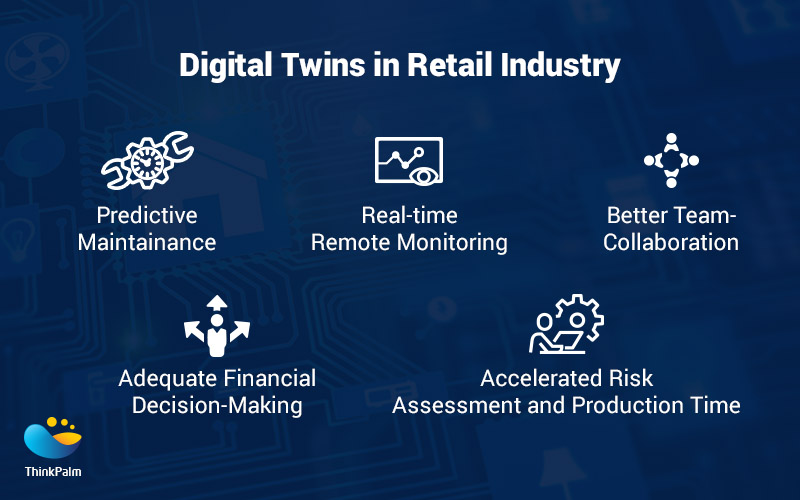


Digital twin technology in the retail sector is revolutionizing the way businesses manage operations, customer experiences, and supply chains.
Here are nine detailed use cases that illustrate how digital twins can transform the retail industry:
Digital Twin Technology for Store Layout Optimization
Digital twins allow retailers to simulate and analyze different store layouts to understand how changes affect customer flow and interaction with products. By tracking movement patterns, retailers can design store layouts that enhance the shopping experience and increase sales.
Inventory Management
Retailers use digital twins to replicate their inventory systems, enabling them to monitor stock levels in real-time, predict stock-outs, and optimize restocking processes. This reduces the risk of overstocking or stockouts, ensuring that popular items are always available.
Supply Chain Visualization
Digital twins provide a comprehensive view of a retailer’s supply chain, allowing for real-time tracking of goods from suppliers to warehouses to store shelves. This helps in identifying bottlenecks, optimizing logistics, and reducing transportation costs.
Customer Behavior Analysis
By creating digital twins of customers based on their shopping habits and preferences, retailers can predict future purchases and personalize marketing efforts. This targeted approach improves customer satisfaction and loyalty.
Product Placement Strategy
Retailers can use digital twins to test and measure the impact of product placements within stores. Simulating different scenarios helps in determining the most effective locations for products to maximize visibility and sales.
Energy Management
Digital twins help retailers monitor and manage the energy usage of their stores. By analyzing data on lighting, heating, and air conditioning, retailers can optimize energy consumption, reduce costs, and lower their environmental impact.
Virtual Store Tours
Retailers can offer virtual reality tours of their stores, powered by digital twins. This allows customers to explore stores remotely, enhancing the shopping experience and reaching a broader audience.
Emergency Response Planning
Digital twins enable retailers to simulate emergency scenarios (like fires or natural disasters) to plan and test their response strategies. This ensures staff are well-prepared and safety measures are effective, minimizing risks to customers and staff.
E-commerce Integration
For online retail, digital twins of physical products allow customers to see highly accurate 3D models of items before purchasing them online. This helps reduce the uncertainty associated with online shopping and decreases return rates.
Digital twin technology is increasingly being used in the retail industry to enhance various aspects of business operations and customer experience.
Here are some real-life implementations:
- Supply Chain Optimization: Microsoft highlights the use of digital twins in retail supply chains, enabling businesses to simulate and optimize operations, thus providing real-time insights that go beyond traditional predictive models. This application helps in navigating disruptions like those experienced during COVID-19 by rapidly adapting to changes in demand and supply dynamics (Microsoft Cloud).
- In-Store Planning and Management: As discussed in Matterport’s insights, digital twins facilitate precise in-store planning and management. They provide a dimensionally accurate replica of retail spaces, which helps in planning layouts and optimizing space utilization without the need for physical presence, thereby saving time and reducing costs (Matterport).
- Enhancing Customer Experience: According to Challenge.org, digital twins can significantly enhance customer service by creating virtual models of customers to predict shopping behaviors and preferences. This digital twin technology also allows for better management of product life cycles and customization of offerings to match consumer demands more accurately (Challenge Advisory).
- Operational Efficiency and Decision Making: EY discusses how digital twins contribute to smarter decision-making in retail by enabling end-to-end visibility of the supply chain. This allows for better management of resources, prediction of supplier issues, and effective distribution flow adjustments (EY US Home).
Digital Twin Technology for the Telecommunications Industry
This industry uses digital twins to manage networks and optimize the deployment of infrastructure. They also help in monitoring system performance and predicting future network needs to handle data traffic effectively.
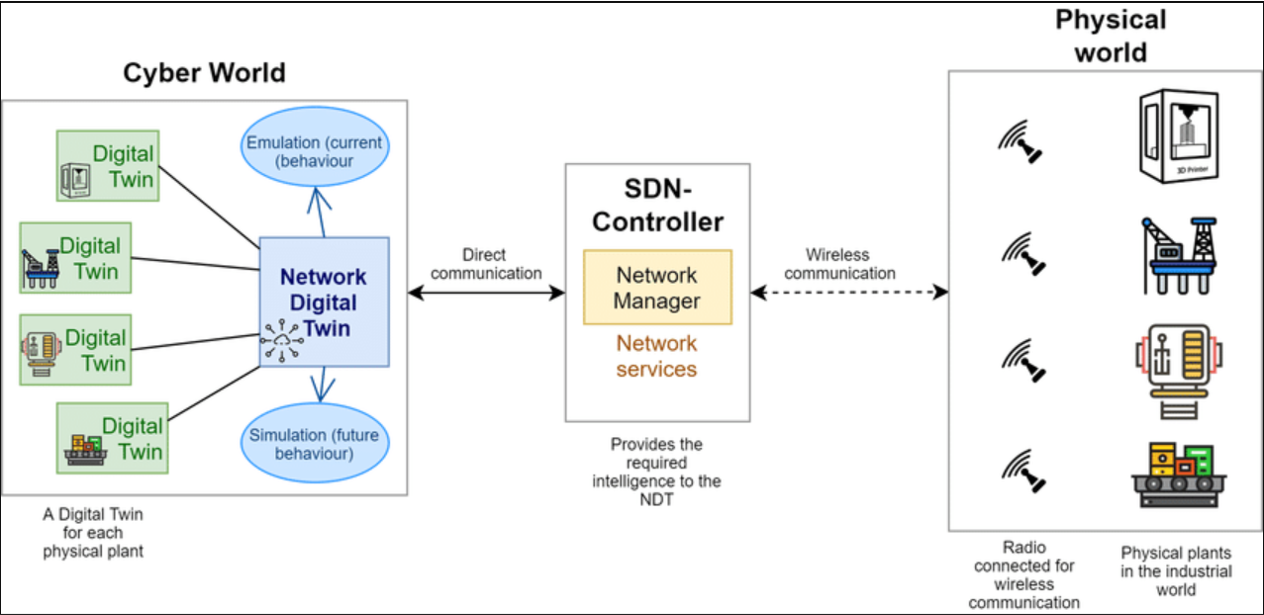


Digital twin technology in the telecommunications industry is a game-changer, offering enhanced network management, service reliability, and customer experience.
Here are nine detailed use cases where digital twins are making a significant impact:
Digital Twin Technology for Network Equipment Maintenance
Digital twins can simulate the conditions of network equipment such as cell towers, routers, and switches to predict failures before they occur. This proactive maintenance approach reduces downtime and ensures consistent network availability.
Network Optimization
By creating virtual replicas of network infrastructure, telecommunications companies can analyze data traffic and optimize the flow to prevent congestion. This leads to improved network performance and customer satisfaction.
Disaster Recovery Planning
Digital twins help in planning and testing disaster recovery strategies by simulating various disaster scenarios. This enables telecom companies to have robust contingency plans that ensure quick recovery of services in case of disruptions.
Capacity Planning
Telecom operators use digital twins to forecast future network demands based on various growth scenarios. This assists in scaling infrastructure efficiently and cost-effectively to meet anticipated customer needs.
Customer Experience Management
Digital twins model the network as experienced by users, allowing telecoms to monitor service quality in real-time and adjust parameters to enhance the user experience.
Integration of New Technologies
As telecoms evolve with technologies like 5G and IoT, digital twins allow for the testing and integration of these technologies within existing networks before full-scale deployment.
Energy Management
Digital twins can simulate and analyze energy consumption across network operations to identify savings opportunities and implement energy-efficient practices.
Security Management
By simulating cyber-attacks on networks, digital twins help in identifying vulnerabilities and strengthening security measures to protect data and services.
Training and Simulation
Digital twins provide realistic and detailed environments for training network technicians and planners, which improves their understanding of network complexities and operational challenges.
Digital twin technology is increasingly pivotal in the telecommunications industry, offering sophisticated solutions for network management, optimization, and service delivery.
Here are some real-life examples of how digital twins are being implemented in this sector:
- Ericsson: They utilize digital twins for network optimization and management, particularly in 5G networks. This includes modeling network components like signals, coverage, and traffic behavior, which allows for safer and more efficient network adjustments without compromising service quality. Their approach includes using digital twins to lower transmitted power while improving network performance, demonstrating significant improvements in user experience (Ericsson) (Ericsson).
- Swisscom: In partnership with Ericsson, Swisscom in Switzerland uses digital twins to navigate strict regulatory environments while deploying new 5G sites. By modeling various network scenarios and adjusting the radiated power, Swisscom has managed to enhance coverage and user experience without violating regulations (Ericsson).
- AT&T: They use digital twins to manage and optimize their network operations more effectively. By creating a virtual model of their network infrastructure, AT&T can simulate the impact of various network configurations and environmental conditions to improve service reliability and performance without disrupting actual network operations.
- Deutsche Telekom: This telecommunications giant employs digital twins to enhance the precision of their network planning and optimization processes. The digital twin technology allows them to anticipate network loads and optimize capacity planning, ensuring a smoother user experience while managing costs effectively.
- Verizon: Verizon uses digital twins for optimizing their data center operations and improving energy efficiency. The digital replicas help them monitor real-time energy usage and environmental conditions, enabling proactive adjustments that lead to significant cost savings and sustainability benefits.
- Telefónica: They utilize digital twins to test new network technologies and services before deployment. This approach helps them reduce the risk associated with new deployments and ensures compatibility and performance standards are met.
- BT (British Telecom): BT has implemented digital twin technology to simulate their entire network operation, which allows them to test the impact of potential changes in the network architecture or to troubleshoot issues before they affect customers.
